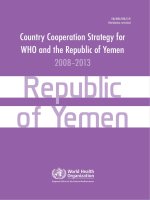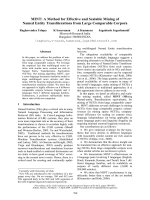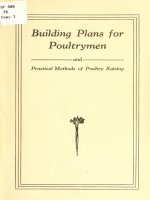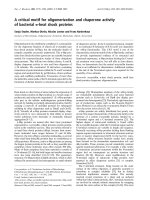Micro-finance for poor and non-poor communities of Nepal
Bạn đang xem bản rút gọn của tài liệu. Xem và tải ngay bản đầy đủ của tài liệu tại đây (448.1 KB, 8 trang )
TRIBHUVAN UNIVERSITY JOURNAL, VOL. 32, NO. 2, DECEMBER, 2018
135
MICRO-FINANCE FOR POOR AND NON-POOR
COMMUNITIES OF NEPAL
Chandra Prasad Dhakal*
ABSTRACT
The micro-finance institutions are providing service to the people
with the noble purpose to improve their socio-economic status which
ultimately helps to reduce the poverty Nepal. In the Nepalese context,
micro-finance institutions are providing the equal services to all people
living in the remote and rural areas. The main objective of this study
was to identify the economic importance of micro-finance institutions for
poor and non-poor communities of Nepal. The study was conducted in
Syangja district among the 385 beneficiaries of micro-finance. This study
found that there was no significant association between the poor and
non-poor people regarding the success of small scale business with the
support of micro-finance, and increasing the amount of saving because p
= .524 and .402 respectively which was greater than .05 significant levels.
The difference could be observed in the increase in income level of poor
and non-poor. Slight better improvement could be seen among the poor
people, there was significant association between poor and non-poor
because of p = .019.
Keywords: Economic, importance, micro-finance, Nepal, poor
INTRODUCTION AND OBJECTIVE
Agriculture is the backbone of developing countries of the world
and this segment has an enormous potential to support the agricultural
growth and economic advance and can reduce poverty (Zeller, 2003).
Nepal is an agricultural country because of 1362908.2 hector of land being
suitable for paddy production, 745823.164 hector land is suitable for wheat
production, 891583 hector land is suitable for maize, 266799 hector land is
suitable for millet, 28361 hector land is suitable for Barley (CBS, 2016). In
this context, development activities focusing on the poverty reduction were
started in 1994 under the auspices of the South Asia Poverty Alleviation
Program (SAPAP) of the UNDP, received millions of dollars of international
investment and has become a model for national development. Syangja's
model was proved to be successful that the Government of Nepal joined
*
Mr. Dhakal is a Lecturer, Saraswoti Multiple Campus, Lekhnath Marg, TU.
136 MICRO-FINANCE FOR POOR AND NON-POOR COMMUNITIES OF NEPAL
forces with the SAPAP to extend the project to other districts and make
it a model for national development. Micro-finance activities were also
initiated before two decades with the objective of poverty reduction. Very
poor, disadvantage, marginalized and women were the main target group
of micro-finance activities. The main objective of almost all microfinance
institutions is to deliver financial services to the poor. Microfinance refers
to the delivery of financial services such as credits, savings, insurance
and other facilities to shoppers who are without access to the services of
formal sector, financial institutions on sustainable basis (Hashemi, Schuler,
Sidney, & Riley, 1996). Microfinance became one of the important tools
of reaching the poor who had very limited access to the formal financial
sector. Very limited researches concerning improving the financial sector
have been observed (Wolday, 2005).
Financial services to poor people, particularly from rural areas
may help farmers to access new technologies and high yield varieties for
agriculture production. Provision of financial services and products has
trickle-down effects on the poor’s livelihood. Microfinance for agriculture
has the potential to address all factors, which are linked to poverty reduction,
e.g. improved health, better education, better agricultural practices and
employment opportunities (Komives, Halpern, Foster, & Wodon, 2005).
Poverty alleviation is very massive and broad issue that encompasses
government policies, education, health care, rural substructure, employment
prospects, provision of credit and financial services. Poverty reduction is a
main planning instrument in improvement and there are number of poverty
reduction strategies. It is not possible to address all strategies separately
in this limited study. However, this study identifies microfinance for rural
agriculture as an important strategy for poverty reduction in the rural
agricultural sector. Because in this technologically advanced era the farmers
must have knowledge of crop variety, weather, fertilizer etc. to maximize
production and profits. Rural infrastructure is necessary to carriage the
products to main agricultural markets. Provision of credit and financial
services is one of the key approaches of poverty reduction that increases
the confidence of poor to take initiative to start new microenterprises in
developing countries. Therefore, the features of the policy have strong
potential to alleviate poverty from any poor country.
Micro-finance is one media to support the community to improve
their economic status. Microfinance programs and institutions have become
an increasingly important component of strategies to reduce poverty or
TRIBHUVAN UNIVERSITY JOURNAL, VOL. 32, NO. 2, DECEMBER, 2018
137
uphold micro and small enterprise development. However, knowledge about
the achievements of such initiatives remains only partial and contested.
At one extreme are studies arguing that microfinance has very beneficial
economic and social impacts (Hossain, 1988). In the context of Nepalese
economics, it has been found used in Nepal only in the later part of 1990s.
Although rustic credit in Nepal began in 1956 with the opening of Credit
cooperatives in Chitwan Valley to provide loans to the re-settlers coming
from different parts of the country (Shrestha, 2009, p. 11). Since then,
Micro-finance institutions are providing the service to the rural society. So,
it is equally important for the all regional people; either poor or rich because
it has been providing the saving, credit service to all. The main objective of
this study is to identify the economic importance of micro-finance to poor
and non-poor people of Nepal; basically in the case of Syangja district.
METHODOLOGY AND STUDY AREA
This study is based on
the descriptive and exploratory
design. The data was collected
from the Syangja district
among the 385 beneficiaries
of Micro-finance. Syangja
District, a part of Province
No. 4 out of 7 Province, is
one of the seventy-seven
districts of Nepal as the new
administrative division under
the Constitution of Nepal
2072 BS. It was a cross-section study. It is pure quantitative study; data
was collected by using the structured questionnaire survey. The sample
size was calculated by using the sample calculation formula; 95 percent
confidence levels, 5 percent margin of error. The simple random sampling
technique was used to select the name of beneficiaries. The study had
collected the list of beneficiaries from the Micro-finance offices and did the
lottery method to select the respondent. The study took only one respondent
from one household. It was done household survey. The researcher visited
the individual house and took the pre-consent from respondent for data
collection. The instruments were pre-tested to ensure the quality of data.
The collected data was analyzed from the SPSS and presented in the tabular
form. The study had divided the total respondent in between poor and non-
138 MICRO-FINANCE FOR POOR AND NON-POOR COMMUNITIES OF NEPAL
poor by following the poverty likelihood legacy definition lines following
the National Poverty Line. The cross-tabulation, mean and Chi-Square test
were run to analyze the data. Statistical difference was observed between
the poor and non-poor.
ANALYSIS
The respondents were asked about role of microfinance to promote
small scale businesses. The following table shows the results.
Table 1: Small Scale Businesses Based on Microfinance
Count
National Poor
%
standard
of
Non Count
poverty poor
%
Total
Strongly
agree
Agree
Undecided
Disagree
Strongly
disagree
Responses Analysis About Small
Scale Business Based on Microfinance
Total
4
12
51
55
18
140
2.9
8.6
36.4
39.3
12.9
100.0
14
15
100
86
30
245
5.7
6.1
40.8
35.1
12.2
100.0
Count
18
27
151
141
48
385
%
4.7
7.0
39.2
36.6
12.5
100.0
Mean
3.50
3.4204
3.4519
Chi-Square Tests
Value df
Pearson Chi-Square
3.207
Asymp. Sig. (2-sided)
4
.524
Source: Field survey, 2016
The results show that out of 385 respondents, 18(4.7%) strongly
disagreed, 27(7%) disagreed, 151(39.2%) were undecided, 141(36.6%)
agreed and 48(12.5%) strongly agreed on success of small-scale businesses
where microfinance banks invested with mean value of total is 3.4519. In
comparison of poor and non-poor, the mean value of poor is 3.5071whereas
mean value of non-poor is 3.4204. The statistical analysis of Chi-Square
test shows that there is no significant association between poor and nonpoor regarding the success of small-scale businesses where microfinance
banks invested because the P = .524 which is greater than .05 significant
level (Table 1).
TRIBHUVAN UNIVERSITY JOURNAL, VOL. 32, NO. 2, DECEMBER, 2018
139
The result is not as satisfactory as objective of microfinance
institutions because those institutions' main goal is to uplift small-scale
investors. Further, they need to correct it.
Opinions of respondents about their increment of income after
joining microfinance banks were taken. The following table shows the
results of it.
Table 2: Income Status After Joining Microfinance
National
Count
Poor
%
standard
Non Count
of
poverty poor %
Count
Total
%
Pearson Chi-Square
Strongly
agree
Agree
Undecided
Disagree
Strongly
disagree
Analysis About Income Status After
Joining Microfinance
Total
3
2.1
2
16
11.4
13
16
11.4
55
87
62.1
147
18
12.9
28
140
100.0
245
0.8
5.3
22.4
60.0
11.4
100.0
Mean
3.7214
3.7592
5
29
71 234
46
385
3.7455
1.3
7.5
18.4 60.8 11.9
100
Chi-Square Tests
Value df
Asymp. Sig. (2-sided)
11.727 4
.019
Source: Field survey, 2016
Income determines the economic status of people. Out of 385
respondents, 5(1.3%) strongly disagreed, 29(7.5%) disagreed, 71(18.4%)
were undecided, 234(60.8%) agreed and 46(11.9%) strongly agreed with
mean value of total is 3.7455. In comparison of poor and non-poor, the
mean value of poor is 3.7214 whereas mean value of non-poor is 3.7592.
The statistical analysis of Chi-Square test shows that there is significant
relationship between poor and non-poor regarding the incensement in
income with support of microfinance banks because the P = .019 which is
less than .05 significant level. The result shows that microfinance banks are
helping in poverty reduction (Table 2).
The respondents were asked whether their savings have been
increased after joining microfinance programs or not. The results of it are
shown in the following table.
140 MICRO-FINANCE FOR POOR AND NON-POOR COMMUNITIES OF NEPAL
Table 3: Status of Saving After Joining Microfinance
National Poor Count
%
standard
of
Non Count
poverty poor %
Count
Total
%
Pearson Chi-Square
3
10
23
92
2.1
7.1 16.4 65.7
2
9
46 162
0.8
3.7 18.8 66.1
5
19
69 254
1.3
4.9 17.9 66.0
Chi-Square Tests
Value
Df
4.032
4
Strongly
agree
Agree
Undecided
Disagree
Strongly
disagree
Analysis About Status of Saving
After Joining Microfinance
12
8.6
26
10.6
38
9.9
Total
140
100.0
245
100.0
385
100.0
Mean
3.7143
3.8204
3.7818
Asymp. Sig. (2-sided)
.402
Source: Field survey, 2016
Out of 385 respondents from study areas, 5(1.3%) strongly
disagreed, 19(4.9%) agreed, 69(17.9%) were undecided, 254(66%)
agreed and 38(9.9%) strongly agreed in increment of savings after joining
microfinance programs. The result indicates the positive agreement of
respondents that they experienced the changes in their economic status and
improved the saving with mean value 3.7818 in response of this question. In
comparison of poor and non-poor, the mean value of poor is 3.7143whereas
mean value of non-poor is 3.8204. The statistical analysis of Chi-Square
test shows that there is no significant relationship between poor and nonpoor regarding the increment in saving with support of microfinance banks
because the P = .402 which is greater than .05 significant level (Table 3).
The finding is supported by the previous study also. The studies
carried out by (Pollinger & Cordero, 2007) and Hennessey (Hind, 1997)
confirmed that microfinance in its various models do assist the world
to reduce and alleviate poverty and enhance economic development,
particularly in developing economies. Micro entrepreneurs have difficulty
in accessing capital from mainstream financial institutions for various
reasons ranging from non-availability of appropriate and adequate collateral
and inability of the entrepreneurs to provide acceptable accounting records
of their businesses. Microfinance in many instances has bridged this gap
TRIBHUVAN UNIVERSITY JOURNAL, VOL. 32, NO. 2, DECEMBER, 2018
141
as microfinance institutions have financed many small and medium size
businesses.
CONCLUSION
The study had focused to identify the importance of micro-finance
institution from the economic perspective to the poor and non-poor people.
The study had adopted poverty likelihood legacy definition lines following
the National Poverty Line to divide the total respondent in between poor
and non-poor group. There was 140 (36.4%) were found poor and 245
(63.3%) were non-poor on the national level standard of poverty. The
core objective of micro-finance institutions are to support the poor people
to reduce the poverty though in Nepalese context, such institutions are
providing the service to all types of people basically living in the rural and
remote areas. In case of Syangja district, almost equal number of poor and
non-poor people were benefited from the micro-finance service to promote
the small scale business and improving in saving. There was no significant
association between the poor and non-poor community in these situation.
But there was slight difference was observed in the improvement of income
in poor and non-poor people. Slight better change was observed among the
poor people than non-poor people.
REFERENCES
Central Bureau of Statistics. (2016). Statistical pocket book Nepal,
Kathmandu: Author.
Hashemi, S., Schuler, R., Sidney, S., & Riley, P. (1996). Rural Credit Program
and Women’s Empowerment in Bangladesh. World Development ,
24, pp. 635-653.
Hind, A. (1997). The changing values of the co-operative and its business
focus. American Journal of Agricultural Economics , 79 (4),
pp.1077-1082.
Holcombe, S. (1995). Managing to empower: The Grameen Bank’s
experience of poverty alleviation. London: Zed Press.
Hossain, M. (1988). Credit for alleviation of rural poverty: The Grameen
Bank in Bangladesh. Washington DC: IFPRI.
Komives, K., Halpern, J., Foster, V., & Wodon, Q. (2005). Water, electricity
and the poor: Who benefits from utility subsidies. Washington:
World Bank.
142 MICRO-FINANCE FOR POOR AND NON-POOR COMMUNITIES OF NEPAL
Otero, M., & Rhyne, E. (1994). The new world of microenterprise finance.
London: IT Publications.
Pollinger, O., & Cordero, G. (2007). The question of sustainability for
microfinance institutions. Journal of Small Business Management,
45 (1), pp. 23-41.
Shrestha, S. M. (2009). State of microfinance in Nepal. Kathmandu: Institute
of Microfinance.
Wolday, A. (2005). Prudential regulation of the microfinance institutions .
Ethiopia: Association of Ethiopian Microfinance Institutions.
Zeller, M. (2003). Models of rural finance of rural financial institutions,
Baltimore, USA: World Council of Credit..









